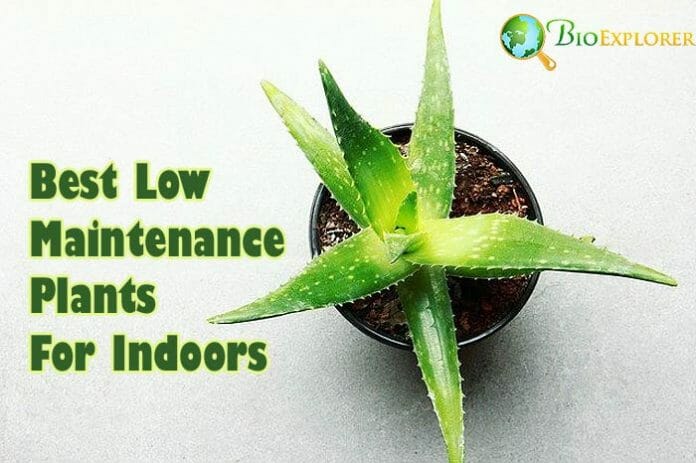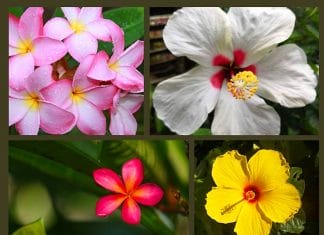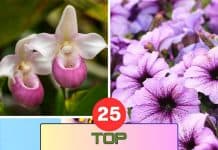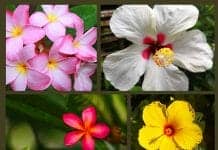
Best Low Maintenance Plants For Indoors: If you like indoor plants, but you don’t have too much time to take care of them, you came to the right place. We gathered the best indoor plants that are low maintenance so you can choose the one that is best for you.
Some plants require more attention than others. However, if you don’t have the experience, time, or interest to care for such plants, there are decorative ones that will be very easy to maintain. Keep reading to find ten of those low-maintenance plants for your home!
Table of Contents
- Importance of indoor plants
- Best low maintenance plants for indoors
- 1. Snake plant (Dracaena trifasciata)
- 2. Ponytail palm (Beaucarnea recurvata)
- 3. ZZ plant (Zamioculcas)
- 4. English Ivy (Hedera helix)
- 5. Baby rubber plant (Peperomia obtusifolia)
- 6. Chinese money plant (Pilea peperomioides)
- 7. Spider plant (Chlorophytum comosum)
- 8. Devil’s Ivy (Epipremnum aureum)
- 9. Jade plant (Crassula ovata)
- 10. Philodendron (Philodendron Schott)
Importance of indoor plants
Indoor plants have plenty of benefits to bring to your home. You might want to consider having at least one plant in each room.
Here are some of the essential benefits of having plants inside your home.
A) They absorb the Carbon Dioxide and offer you Oxygen
The main benefit of indoor plants is that they convert carbon dioxide into Oxygen. Your air will be fresher and richer in Oxygen as the toxins become fewer thanks to your indoor plants that also get rid of different pollutants. This is an excellent reason to have at least one plant in your office as well, not just in your home.
Suggested Reading:
Carbon Cycle Steps: Overview & Importance in Biosphere
![]()
B) Decorative Benefits
These plants can add a terrific aesthetic benefit to your space. You can choose different indoor plants that add beauty to your space and give it a fresh vibe. You will be impressed by the variety of indoor plants you can find on the market. Some create unique flowers, while others are easily noticeable thanks to their leaves.
Suggested Reading:
6 Best Indoor Vegetable Garden Systems Reviews
![]()
C) They can improve your mood
Having a plant close to you can make you feel better and more optimistic. They reduce stress levels and help increase concentration levels at the same time. You will be more creative and relaxed, which are essential aspects of everyone’s well-being.
Suggested Reading:
Top 26 Best Hawaiian Flowers
![]()
Best low maintenance plants for indoors
1. Snake plant (Dracaena trifasciata)
The first indoor plant on our list is the snake plant. It is a popular indoor plant that will compliment your home or office perfectly. This plant has an attractive pattern on its leaves that grow vertically. All you will see are the leaves that sprout from the roots that are underground. When they reach maturity, these leaves get darker in color, and they get to 70 cm long as well as 5 to 6 cm wide.
Snake Plant Classification
The Snake plant is an evergreen perennial plant from the family Asparagaceae, found most often in Africa. Until 2017, the name of this plant was Sansevieria trifasciata. You can also find it under more famous names such as mother-in-law’s tongue or Saint George’s sword.
How tall can the snake plant grow into?
This plant can get as high as 2.3 ft to 3 ft, roughly 90 cm, once it reaches maturity. There are strains of snake plants, especially those that grow outdoors, that can even reach up to 6ft (2m) in height.
Why is the snake plant suitable indoors?
If you are looking for a low-maintenance plant to grow inside your house, the snake plant might be one of the best options for you.
- It can survive with little water and even withstand drought conditions. Snake plant doesn’t need a lot of sun.
- It will grow in more or less sunlight, depending on the conditions you have at home. You can even water it once a month or once every couple of months during the humid months of winter.
- Watering this plant too often can cause it to rot, so you don’t want to take that risk.
How to take care/to maintain the snake plant?
It is not a lot in terms of maintaining a snake plant.
- You can place the pot anywhere in the house, and it will look great and thrive.
- Watering will not be a problem since it can last months without water during winter.
- On the hot summer days, you might have to water it weekly. Check the soil to determine when some water is needed.
- You will not have to trim it or do any maintenance tasks. An important aspect is to change the pot as the plant grows, so the roots have the space they need.
Benefits of the snake plant
Even if the snake plant is a low maintenance one, it will bring plenty of benefits to your home. This plant emanates enough Oxygen to purify the air in your room, and it is known for relieving stress. This plant will offer you more Oxygen than others, but it can also reduce the toxins in the air.
Where to find snake plants?
These plants thrive in tropical and sub-tropical climates such as Asia, Europe, and Africa. However, there are about 70 strains of snake plants, and nowadays, you can find some of them all over the world since they adapt so well to different conditions.
![]()
2. Ponytail palm (Beaucarnea recurvata)
The ponytail palm plant looks just like its name suggests. It has the structure of a palm with thin, green leaves that hang down around its stem. Since it only comes in green color, I will look great in all types of backgrounds, from a home one to an office.
Ponytail Palm Classification
| Plantae | Asparagales | Asparagaceae | Beaucarnea | Beaucarnea recurvata |
This plant is a perennial evergreen one which means that it can live more than two years. It can last more than 15 years in an apartment in rough conditions. There were ponytail palm plants that survived over 300 years in Mexico. After the first ten years, these plants can create beautiful white flowers that make them even prettier for your home.
How tall can the Ponytail Palm grow into?
The ponytail palm plant can reach impressive heights of 15 ft and 6 inches (4.7 m). the stem or caudex of the plant will expand over time to store enough water for its needs. However, if you have a plant of these indoors, you can trim its leaves to not take so much space. Different variations of this plant will not grow as tall as those you see outdoors.
Why is Ponytail Palm suitable for indoors?
This plant can grow beautifully inside your home because it doesn’t require any special conditions. It will survive even in poor light, and it doesn’t always need direct sunlight. It needs water, but if you forget to water it a day and even more, it will not die. Because it is a succulent plant, it will retain the water to use later, so it will take a long time to die of thirst. Plus, it looks beautiful in any room you decide to put it in.
How to take care/to maintain the Ponytail Palm?
Taking care of these plants is not complicated at all. They can thrive in both direct sunlight or shade, and they are ideal for indoor plants. They can’t grow in extremely cold environments, which makes them great for indoors. It is important not to over-water them because they can become infested with insects. These plants can live up to three weeks without water. Check the soil of your plant and only water when it is dry. Another important aspect is to keep its roots intact as you relocate it to a new pot.
Benefits of the Ponytail Palm
Besides the beauty of ponytail palm plants, you will also enjoy the fresh air they offer to your environment. Since they are not toxic, you can have them in your home even if you have pets. They are easy to maintain and can last a long time even in less than optimal conditions.
Where to find Ponytail Palm?
You can find ponytail palm plants in regions with temperate climates. These plants thrive in spring-like weather, but they don’t do very well in cold weather. They can be found on rocky soils as these plants don’t need too many nutrients.
![]()
3. ZZ plant (Zamioculcas)
If you are looking for a plant that looks joyful and brings life to your home while it is low maintenance, the ZZ plant is your choice. These plants have no stems above the surface of the soil, and they have evergreen leaves. Their branches can reach between 45 to 60 cm tall or 17.7 inches to 23 inches. The color of these leaves is usually dark green and has a smooth and shiny look.
ZZ Plant Classification
This plant is a tropical perennial from Africa that belongs to the Araceae family. The Zamioculcas zamiifolia is the only species in this family, though, and it originates in Eastern Africa. You will find it under different names such as Zanzibar gem, Zuzu plant, ZZ plant, or emerald palm.
How tall can the ZZ plant grow into?
This plant will not grow very tall, but it will thrive enough to add some life to your home. This plant’s maximum height that could reach indoors is 23 inches, but not all of them make it to this height. The conditions they grow in are also necessary.
Why is the ZZ plant suitable indoors?
The ZZ plant is easy to grow in many conditions, so it is suitable for busy people. This plant can survive several months without water and in low light conditions. You can place it in the corner of your room and forget about it, and it will not die. It is easy to maintain, but it also brings a great aesthetic advantage to your home.
How to take care/maintain the ZZ plant?
It takes nothing to maintain a ZZ plant thriving. Besides the fact that you will have to water it rarely, it can survive almost any light conditions. All you have to be careful is not to place her in an environment with temperatures lower than 15 degrees C or 59 degrees F as it might not make it.
Benefits of the ZZ plant
The main benefit of a ZZ plant inside your house is that it can reduce and even remove the Toluene and Xylene from your air to breathe a better air quality. But it will also embellish your space and help you reduce stress if you have it in your office.
Where to find the ZZ plants?
You can find this plant originated in Africa, but it is grown worldwide nowadays. The optimum temperatures for the ZZ plant are 18°C to 26°C (65° to 79°F). So, any region with this climate will support the ZZ plant and allow it to thrive.
![]()
4. English Ivy (Hedera helix)
English Ivy is a more popular plant that can be great for both indoor and outdoor growing. The clinging vine of this plant will dress your walls in lovely green leaves. It is a great decorative plant, and it will not lose its green beauty even without any type of maintenance.
English Ivy Classification
| Plantae | Apiales | Araliaceae | Hedera | Hedera helix |
This flowering plant comes from the Araliaceae family, and it is an evergreen vine. You will find it growing naturally on walls and on trees, fences, and in gardens. You will find it under names such as Hedera acuta, Hedera grandifolia, Hedera Arborea.
How tall can the English Ivy grow into?
This plant will climb as tall or as high as the support it is attached to is. If you set it up on the wall, it will grow along with the height and surface of the wall. Left uncut or trimmed, this plant can reach 20 to 30 m or 66 to 98 ft.
Why is English Ivy suitable for indoors?
First of all, this plant will be extremely easy to grow. All you need is to plant it in a proper pot or basket and let it take off around the walls of your room. It will thrive in all types of light, although it will prefer medium and bright levels.
How to take care/to maintain English Ivy?
This plant needs medium or bright light to thrive. You don’t have to water it every day because this plant doesn’t like a lot of water. You can water it once you notice the soil is dry. Trimming might be necessary depending on the direction the ivy plant grown into.
Benefits of the English Ivy
English Ivy can offer you some welcome cooling atmosphere during summer days if you grow it indoors. They look beautiful and are low maintenance, so you get to enjoy them with no stress. Also, during winter, this plant can offer a level of insulation to your home. The plant itself has some excellent properties for our health. It is an anti-inflammatory, antioxidant, antiarthritic plant.
Where to find English Ivy plants?
You can find these plants mainly in cooler climates such as central and northern Europe. There are several species of Ivy plants, though, and some of them will withstand cooler temperatures.
![]()
5. Baby rubber plant (Peperomia obtusifolia)
You will fall in love with this plant as soon as you see it and find out how easy it is to maintain. It is small in size with thick green leaves, and it has white flowers. The leaves are leathery and look like small cups, which compliments the name of the plant beautifully.
No products found.
Baby rubber plant Classification
| Plantae | Piperales | Piperaceae | Peperomia | Peperomia obtusifolia |
This plant comes from the family Piperaceae, and it is a beautiful flowering plant. It is a perennial evergreen plant that can embellish your home or office for many years to come.
How tall can the Baby rubber plant grow into?
If you wonder how tall this plant can grow, you will love to hear that it can get to only 25 cm, which is 10 inches in height. Since it is so tiny, it is ideal for having it inside your house. This plant can also create white flowers with 12 cm, making them beautiful decorations for your space.
Why is the Baby rubber plant good for indoors?
Baby rubber is ideal for your house and your office because it is small and easy to maintain. Plus, it looks beautiful in any room in your house. This plant will need only average lighting and watering as often as you notice the soil being dry.
How to take care/to maintain Baby rubber plants?
Baby rubber is primarily an indoor plant and very easy to grow. You will need to offer it a temperature of a minimum of 15 degrees C or 59 degrees F. You can place this plant in medium light or bright sight as long as you don’t leave it in the dark, it shall thrive. Most likely, your baby rubber plant will be happy if you water it once a week.
Benefits of the Baby rubber plant
This plant is easy to grow and hypoallergenic, making it much more suitable for an indoor environment. It will remove toxins in the air as well, leaving your space with better air to breathe.
Where to find Baby rubber plants?
This plant is original to Mexico, Florida, and the Caribbean. Still, you will find it in other corners of the world as well.
![]()
6. Chinese money plant (Pilea peperomioides)
The Pilea Peperomioides plant, also known as the Chinese money plant, is an excellent choice for your indoor environment as well. It looks gorgeous with round leaves that come in a dark green shade. The diameter of these leaves can be 10 cm or 4 inches with a greenish stem that can get to be a dark brown shade as the plant matures. You can place it anywhere in your home or office, and it will look great.
No products found.
Chinese money plant classification
This plant is a perennial evergreen plant in the family Urticaceae. It is a flowering plant that comes from China. You will find this plant under the name of missionary plant as well.
How tall can the Chinese money plant grow into?
The Chinese money plant can grow up to 30 cm or 12 inches tall, a very comfortable size for your home. You can put it in any room and even on your porch or balcony, and it will look great!
Why is the Chinese money plant good for indoors?
Chinese money plant is perfect for indoors thanks to its small dimensions and low maintenance. It will look great in any room of your house and even in your office. You can also plant it in a terrarium for a more intense aesthetic impact.
How to take care/to maintain Chinese money plants?
Chinese money plant requires temperatures of a minimum of 10 degrees C or 50 degrees F. In terms of water, it is best to check the soil before you decide if your Chinese money plant needs water or not. The recommendations say to water it when the soil is 2″ to 3” dry. In general, watering this plant weekly should be enough.
Benefits of the Chinese money plant
The Chinese money plant is known for purifying the air and getting rid of different airborne pollutants such as Formaldehyde, Benzene, Xylene, and Carbon dioxide. This plant can also keep you calm and help you deal with stress. As the name of this plant suggests, it will bring good luck and abundance to your home too.
Where to find Chinese money plants?
The Chinese money plant can be found in Chine in its natural habitat, but you can grow it anywhere in the world if you keep its maintenance needs. Naturally, it grows in forests and rocky areas at altitudes of over 1500 m.
![]()
7. Spider plant (Chlorophytum comosum)
The spider plant looks similar to a spider as it has many green leaves that are thin and long, making us think of the legs of a spider. Occasionally, this plant can create flowers as well, and it can be pretty large in terms of size.
Spider plant classification
| Plantae | Asparagales | Asparagaceae | Chlorophytum | Chlorophytum comosum |
This plant is a flowering plant from the perennial category that will last a long time in your home. You can find it under other names like ribbon plant, hen and chickens plant, or spider ivy.
How tall can the Spider plant grow into?
In terms of height, this plant will grow as much as you allow it with no trimming. Left in its natural shape, it can reach a height of 60 cm or 24 inches tall. The roots are shaped like tubes and can get between 5 cm and 10 cm long (2-4 inches). As for the leaves, these can get anywhere from 20 cm to 45 cm or 8 to 18 inches.
Why is the Spider plant suitable for indoors?
This plant is low maintenance and very flexible. You can put it on a flat surface or hang it from the ceiling, and it will look great in any corner of your home. It doesn’t require much attention, and it will bring you the joy you want every time you look at it.
How to take care/to maintain Spider plants?
Maintaining a spider plant is relatively easy. They thrive in moderate or bright sunlight, and they only need water once a week. If you are unsure whether you should water your spider plant, check out how dry the soil is. When the soil is 1.5 inches dry, you might want to water the plant.
Benefits of the Spider plant
The spider plant will purify the air in your home and absorb carbon dioxide as well as other airborne pollutants. These plants are easy to maintain and non-toxic, so they are safe if you have pets or kids.
Where to find Spider plants?
You can find this plant in its natural habitat in different areas of Africa, such as Eastern Tropical Africa, South Tropical Africa, Southern Africa, and West Tropical Africa and Northern Africa.
![]()
8. Devil’s Ivy (Epipremnum aureum)
His plant got its name because it keeps its green color even if kept in the dark. Devil’s Ivy is an evergreen vine that can uniquely embellish your house. You will love its heart-shaped leaves and the aerial roots that give this Ivy a unique charm. This plant can also flower, but it needs artificial supplements for that.
Devil’s Ivy Classification
Devil’s Ivy is an evergreen perennial plant that belongs to the Araceae family. You can find it under a wide variety of names. They are golden pothos, hunter’s robe, taro vine, marble queen or silver vine, and even money plant in India.
How tall can the Devil’s Ivy grow into?
Devil’s Ivy can grow up to 20 m or 66 inches tall, and it has stems of 4 cm in diameter. However, if you grow this plant indoors, it will climb around your walls according to the direction you set it on, so you will not have to worry about growing too tall.
Why is Devil’s Ivy good for indoors?
Devil’s Ivy is a plant that grows pretty much by itself. It can withstand rough growing conditions, and it is a low-maintenance plant. As long as you water it twice a month and sometimes even less, it will thrive happily in your home. This plant will look great if you hang it from the ceiling or put it on a flat surface, adding style and beauty to your home and purifying the air as well.
How to take care/to maintain Devil’s Ivy?
You don’t need to place this plant in direct sunlight as too much brightness can burn the leaves. The best temperature for this plant are between 17 degrees C and 30 degrees C or between 63 degrees F to 86 degrees F. You will have to water it once every two weeks after you notice the soil is dry to the touch.
Benefits of the Devil’s Ivy
The devil’s Ivy is known for eliminating toxins in the air as part of converting carbon dioxide into fresh Oxygen. It is a beautiful decorative plant that is also very easy to maintain.
Where to find Devil’s Ivy?
Devil’s Ivy grows quickly in tropical countries. It can be found in India, Vietnam, Thailand, Japan, Taiwan, Singapore, Australia, and Hawaii.
![]()
9. Jade plant (Crassula ovata)
The jade plant is an evergreen type of plant with thick branches and thick leaves. Its leaves are shiny and smooth to the touch, and they grow around the branches in pair. This plant is a jade green color, but some strains could have a more yellowish color. Occasionally, the plant can develop white and pink flowers and a reddish tint if it stays in direct sunlight.
Jade plant Classification
| Plantae | Saxifragales | Crassulaceae | Crassula | Crassula ovata |
The jade plant is a succulent plant that belongs to the Crassulaceae family. This plant is also known as the lucky plant or money tree, and it is effortless to grow even for beginners.
How tall can the Jade plant grow into?
The maximum height of the jade plant can reach 2.5 m; however, if you grow it indoors, you can trim it at your comfortable size. Some strains grow to smaller heights. It can form a trunk of up to 6 cm in diameter, and it has a rich section of roots, so you will need a large pot for it.
Why is the Jade plant suitable for indoors?
Jade plant adds a great aesthetic design to your space, and it requires little water. It is also resembling a miniature tree which will make any room look special. This is a great plant to grow indoors for beginners, thanks to its low maintenance needs.
How to take care/maintain Jade plants?
Like all succulent plants, the jade plant requires little water. During summer days you can water it twice a month and during winter days even less. Too much water can cause its roots to rot, so it is important to not overwater this plant. In terms of sunlight, this plant will thrive if it gets about six hours of moderate or bright sunlight each day.
Benefits of the Jade plant
The Jade plant is a symbol of luck worldwide, besides being a very aesthetic plant to have in your home. This plant also absorbs carbon dioxide during the night and increases humidity in your home. It also purifies your air and gets rid of toxins as well as improves your overall well-being.
Where to find Jade plants?
You can find the jade plant in South Africa, Mozambique, and Eastern Cape in its natural habitat. However, you can find it as a house plant worldwide since it grows in different conditions and is very easy to maintain.
![]()
10. Philodendron (Philodendron Schott)
The Philodendron is a large plant with long and broad leaves. These leaves come in different shapes, such as more round or oval, depending on the strain of this plant. These green leaves can differ even in the same plant. They grow individually from the stem, and the young leaves can look different than the mature ones. The roots of this plant are also areal and underground ones. You will also notice some flowers in certain strains. These flowers can come in various colors, such as white, pink, or yellow.
Philodendron Classification
This plant is part of the Araceae family, and it comes in different strains that can grow in a wide range of conditions. It is a flowering plant, and there are over 489 species registered.
How tall can the Philodendron grow into?
This plant can come in different heights according to the strain it belongs to. In general, the philodendron plant can reach up to 3 feet tall, making it perfect for indoor growing.
Why is Philodendron suitable indoors?
This plant is a surprise altogether. You never know what kind of leaves you will get or see any flowers from it. It is easy to maintain and can withstand even rough growing conditions. Plus, it is known for improving the air quality in the room you put it in to benefit significantly from this plant.
How to take care/to maintain Philodendron?
You should only water the plant when you notice the soil is dry or the leaves are turning a brown color. Too much water can cause the roots to rot and develop pests. In terms of temperatures, you want to grow this plant in temperatures between 65 and 78 degrees F during the day and a minimum of 60 degrees F during the night. It needs moderate or bright sunlight, but it can thrive in the shade as well, so you can put this plant anywhere in your house.
Benefits of the Philodendron
The main benefit of this plant is that it will purify the air in your home. It is known for eliminating toxins such as formaldehyde and improve the level of Oxygen. Besides this critical aspect, the philodendron plant will give your home an exciting image thanks to its unique leaves. It is straightforward to maintain.
Where to find Philodendron plants?
You will find this plant in the Americas as well as the West Indies regions. It thrives in tropical forests as well as river banks and swamps. Thanks to the aerial roots of this plant, you can find it attached to other plants and trees as well.
![]()
Indoor plants can bring a wide range of benefits to your home. If you are unsure what plants to choose for your home or office, this list should get you started. Once you get used to taking care of these essential indoor plants, you can invest in more complex species.
![]()




























